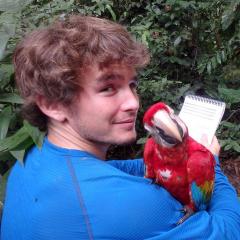The statement “mining threatens biodiversity” is not an overly contentious one among conservation scientists. We’ve all heard of cases where mining and mineral processing have negatively affected species and ecosystems.
For Dr Laura Sonter, UQ senior lecturer and lead of the CBCS research group on mining and conservation, a standout moment took place in Brazil in 2015: “I stood on the side of a road, looking down at Samarco’s tailings dam, thinking about possible impacts of a breach.” Three months later, 50 million cubic metres of mine waste spilled into the biodiverse Rio Dolce river basin and, eventually, the South Atlantic Ocean.
So, yes, mining threatens biodiversity. But the links between mining and conservation are complicated, and mineral production doesn’t need to be bad for biodiversity. In fact, some of us argue that achieving good conservation outcomes in the future will depend on ecologically responsible mining and close collaboration between conservation scientists and the mining sector.
What connects conservation, minerals and mining?
Delivering on many sustainable development goals (SDGs) – including those to conserve life on land and below water – require mineral resources. For example, mitigating climate change and associated biodiversity losses requires a boost in renewable energy production. However, these technologies are materialintensive, and growing the supply of wind, solar and hydropower requires new sources of lithium, cobalt, copper and nickel.
Producing these minerals in an ecologically responsible way will require new tools and conservation approaches. While the leading industry body, the International Council on Mining and Metals, urges member companies to build SDG commitments into corporate policies, guidance is missing on how to operationalise best conservation practice at the scale of a mine site.
There is a huge opportunity to improve biodiversity outcomes from mining and much of this work will benefit from industry collaboration. These partnerships provide access to necessary knowledge, data and resources to conserve biodiversity in mineral-rich regions, which, in Australia, may cover 25% of our landscape.
Recent CBCS highlights
So, what are we doing about this? CBCS research on mining and conservation issues falls across three main topics – here are a few highlights from 2020:
Understanding mining threats to biodiversity
Mining is an important driver of tropical deforestation, habitat loss and fragmentation. PhD student Juliana Siqueira-Gay’s work in the Brazilian Amazon has shown that government proposals to open protected areas to mining may damage culturally significant areas and the valuable ecosystem services these places supply (Siqueira-Gay et al. 2020a, 2020b). Further, preliminary findings from PhD student Tom Lloyd suggest that mineral-rich areas are more biodiverse than sites unaffected by mining. In Colombia, Dr Pablo Negret’s research has revealed a correlation between mining operations and deforestation rates, and that these impacts may have particularly acute consequences for some species and ecosystems if left unprotected (Negret et al. 2019).
Improving policies to conserve biodiversity in mining regions
Compensating for biodiversity impacts of mining will require more conservation effort than is typically required by policies, and the limits to compensation must be factored into decisions to expand mines. In a large collaborative effort to evaluate compensation policies in four countries, including Australia, we showed that there may be insufficient land available to recover the biodiversity needed to achieve No Net Loss (NNL) from mining (Sonter et al. 2020a). Complementing this, Masters of Conservation Biology student Adam Garthwaite investigated potential for biodiversity offsets in Queensland to provide social and ecological co-benefits, showing that more land may be needed if compensation goals extend beyond biodiversity (Garthwaite et al. in prep).
Consequences of mining and conservation for people
The impacts of mining on biodiversity also affect ecosystem services and their contribution to human wellbeing. PhD student Robyn Boldy led a review of mining impacts on ecosystem services to reveal that, of the few analyses conducted in mining regions, the focus has been on a limited set of services of little real value to local communities (Boldy et al. 2021). Robyn’s case study research on bauxite mining in western Cape York is also shining light on opportunities to improve mine site rehabilitation outcomes for ecosystem services valued by local Indigenous people. Contributing to a similar goal, PhD student Jaramar Villarreal-Rosas developed a framework for incorporating ecosystem services, and specifically their contributions to people, into systematic conservation plans (Villarreal-Rosas et al. 2020).
What's next?
A key focus for our research group will be the role of mining in mitigating climate change. Important deposits of energy transition minerals (needed to generate and distribute renewable energy) coincide with conservation sites and priorities (Sonter et al. 2020b). But we don’t yet know how and where to mine these materials so that they avoid causing additional impacts on biodiversity.
Beyond this, there is plenty more research needed to improve biodiversity outcomes of mining and now is a great time to work on this topic. Data and technologies are enabling analyses across the global mining sector and proposed state and national policies provide interesting future scenarios to analyse. Reach out if you’d like to join us!
References
– Negret et al. 2019 Emerging evidence that armed conflict and coca cultivation influence deforestation patterns. Biological Conservation 239, 108176.
– Siqueira-Gay et al. 2020a Exploring potential impacts of mining on forest loss and fragmentation within a biodiverse region of Brazil’s northeastern Amazon. Resources Policy 67, 101662.
– Siqueira-Gay et al. 2020b Proposed legislation to mine Brazil’s Indigenous lands will threaten Amazon forests and their valuable ecosystem services. One Earth 3 (3), 356–362.
– Garthwaite et al. The potential for biodiversity offsets to deliver social and ecological cobenefits in Queensland, Australia. (in prep).
– Boldy et al. 2021 Understanding the impacts of mining on ecosystem services through a systematic review. Extractive Industries and Society.
– Villarreal-Rosas et al. 2020 Advancing systematic conservation planning for ecosystem services. Trends in Ecology & Evolution.
– Sonter et al. 2020a Local conditions and policy design determine whether ecological compensation can achieve No Net Loss goals. Nature Communications 11 (1), 1–11.
– Sonter et al. 2020b Renewable energy production will exacerbate mining threats to biodiversity. Nature Communications 11 (1), 1–6.





